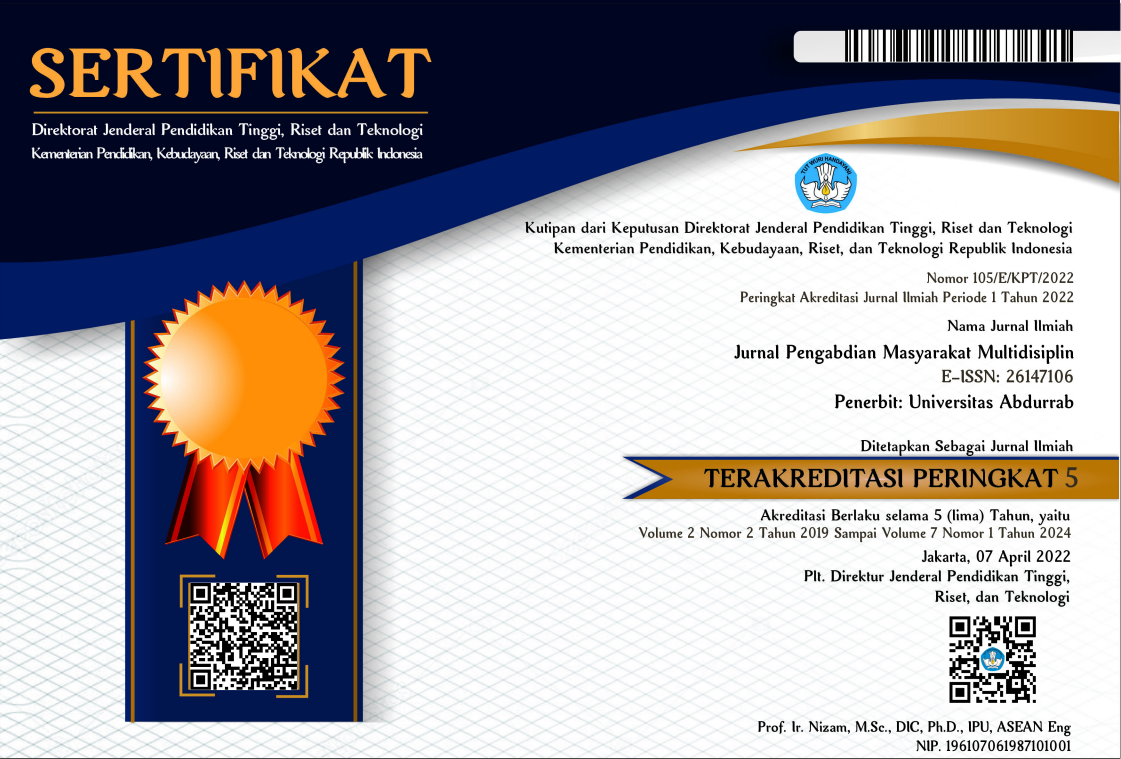INCREASING COMMUNITY AWARENESS TOWARDS HALAL AND THAYYIB PRODUCTS
Abstract
Halal products generally can be seen from the Halal Certificate and or Halal Label on the product packaging. However, halal products often are sold with products that have not been guaranteed to the Halal in one place of display such as in supermarkets or the market, so it can’t be known the halalness of the product. To know halal and thayyib products, knowledge of foodstuffs are classified as halal and thayyib is needed. The purpose of this Community Service (PKM) activity is to socialize and educate related halal and thayyib products, the ingredients used in the product manufacturing process, and the halal critical point of each ingredient and or product. This form of activity is in the form of education and socialization about halal and thayyib materials and or products that enter, circulate, and be traded in the territory of Indonesia. To see the success rate and satisfaction of participants in this PKM activity are done through pretest, posttest, and questionnaire. The result of this PKM is that the participants can understand that the products that enter, circulate, and are traded in the territory of Indonesia are syubhat, so they must be halal certified. In addition, the participants of the PKM program can know and or distinguish what ingredients or products are halal or haram, as well as which are thayyib and which are not thayyib.
References
Aziz, A.Y. and Vui, C.N. “The Role of Halal Awareness and Halal Certification in Influencing Non-Muslim’s Purchase Intention”. University Putra Malaysia. Third International Conference on Business and Economic Research (3rd ICBER 2012) Proceeding, ISBN: 978-967-5705-05-2. 2012
BPOM. “Update Program Prioritas Keamanan Pangan BPOM”. Direktorat Pengawasan Produk dan Bahan Berbahaya, Deputi Bidang Pengawasan Keamanan Pangan dan Bahan Berbahaya. BPOM, Jakarta. 2015
Fadzlillah, N. A., Man, Y. K. B., Jamaludin, M. A., Rahman, S.A., Al-Kahtani, H. A. “Halal Food Issues From Islamic and Modern Science Perspectives”. 2011 2nd International Conference on Humanities, Historical and Social Sciences IPEDR vol.17. IACSIT Press, Singapore.
Girindra, A.” Menjamin Kehalalan dengan Label Halal”. Persfektif Food Review Indonesia Vol.1 No 9. hal.12-13. Bogor. 2006.
Mursyidi, A. “The Role Of Chemical Analysis in the Halal Authentication of Food and Pharmaceutical Products”. J. Food Phar. Sci. 1 (2013) 1 – 4.
Salehudin, I.” Halal Literacy: A Concept Exploration and Measurement Validation”. Dept. of Management, Faculty of Economics, University of Indonesia. Asean Marketing Journal, June 2010 – Vol. II – No. 1.
Wahab, A.R.” Guidelines For The Preparation of Halal Food and Goods For The Muslim Consumers”. HALAL Guidelines for manufacturers. Amal Merge Halal and Food Safety Institute, Malaysia. 2004.
Copyright (c) 2022 Jurnal Pengabdian Masyarakat Multidisiplin

This work is licensed under a Creative Commons Attribution-NonCommercial-ShareAlike 4.0 International License.
1. Copyright of all journal manuscripts is held by the Jurnal Pengabdian Masyarakat Multidisiplin.Formal legal provisions to access digital articles of electronic journal are subject to the provision of the Creative
2. Commons Attribution-ShareAlike license (CC BY-NC-SA), which means that Jurnal Pengabdian Masyarakat Multidisiplin is rightful to keep, transfer media/format, manage in the form of databases, maintain, and
3. publish articles.Published manuscripts both printed and electronic are open access for educational, research, and library purposes. Additionally, the editorial board is not responsible for any violations of copyright law.
licensed under a Creative Commons Attribution-ShareAlike 4.0 International License.
 PDF (Bahasa Indonesia)
PDF (Bahasa Indonesia)
 Abstract views: 364
Abstract views: 364
 downloads: 325
downloads: 325

 :
:




